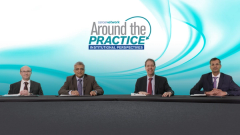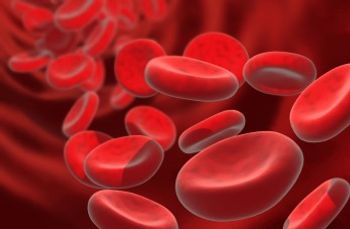
Considerations for Incorporating Daratumumab-Containing Regimens in NDMM
Shared insight on optimizing selection and use of daratumumab-containing regimens in NDMM, with regard for clinical trial readouts in this setting.
Episodes in this series

Transcript:
Shaji Kumar, MD: How would this compare with VRd [bortezomib (Velcade), lenalidomide (Revlimid), and dexamethasone] lite, another triplet that’s been studied in the SWOG study?
David Dingli, MD: The SWOG study, especially if we’re looking at the SWOG S0777 study, looked at VRd. It was a large study, which looked at patients who technically will go to transplant, but in quite a few patients, transplant was not considered early on. Actually, patients were transplant ineligible. If we compare the demographics of the patients in the SWOG S0777 study with those in the MAIA study, in the SWOG trial, patients were substantially younger. Certainly, the Rd [lenalidomide and dexamethasone] arms look very similar in their outcomes. In the SWOG study, the median PFS [progression-free survival] for the Rd arm was 29 months and in the MAIA study it’s about 34 months. I’m doing something that we’re not supposed to do which is to compare across trials. The PFS in the VRd arm was about 41 months compared to approximately 60 months with the MAIA study. Considering everything, I would think for the patient who has standard-risk disease, where we think proteasome inhibitor is quite important, DRd [daratumumab (Darzalex), lenalidomide, and dexamethasone] is a viable option if the patient doesn’t want a transplant or if he’s frail.
Shaji Kumar, MD: If this patient had high-risk characteristics, what would you have used for treatment?
David Dingli, MD: For the high-risk patient, especially with D4, 14, or 17P, I think the proteasome inhibitor is quite important. I would have gone with a triplet, probably VRd lite. If I wasn’t happy with the response, I would probably venture into addition of daratumumab.
Morie Gertz, MD: We need to stop talking about this trial at these types of venues. The accrual for that trial started 15 years ago. It was IV [intravenous] bortezomib. It was twice a week bortezomib and God knows how many people withdrew from the study because of intractable neuropathy. All the supportive care that David talked about, we weren’t routinely using at that time because we hadn’t figured out that very high herpes zoster incidence or the prophylactic antibiotics. That’s a particularly bad example for cross trial comparisons.
David Dingli, MD: I agree at some level, but I think given that the Rd arms had similar outcomes, I think that provides some legitimacy to compare them. The supportive care has changed dramatically and we’ve learned that we need to give bortezomib once a week and give it subcutaneously and we know that the efficacy there is similar. It’s the best we have in the United States for the transplant ineligible.
Prashant Kapoor, MD: That is true. But once again, we are somewhat comparing apples to oranges and that has to be stated upfront. As you correctly pointed out, David, with VRd, there is the twice weekly issue, plus the fact that VRd only used V [bortezomib] for 8 cycles. It’s a fixed duration versus in the MAIA trial, where the triplet is given forever until progression or indefinite or toxicity. These are 2 different studies and I feel because they were conducted at different time periods, it isn’t necessarily fair to compare the 2. We now know with the SWOG 1211 trial, VRd can be given continuously as well if we optimize the dose of bortezomib, which is once weekly. After 8 cycles or so, the SWOG 1211 study dose attenuated bortezomib as well as lenalidomide. There are ways to overcome some of these toxicities that Morie was talking about and that is something we need to take into account.
Going back to Shaji’s question, if this patient had high-risk features, I would have certainly offered transplant if the patient’s performance status had improved. However, because this is a standard-risk patient and the results of the MAIA trial are quite impressive, I think we should continue with the current regimen if the patient is tolerating well. What is not known, however, is whether dara [daratumumab] for maybe 6, 9, or 12 months would have been sufficient in this patient population, or whether adding dara [daratumumab] in patients who were MRD [minimal residual disease] positive at the end of fixed duration induction should be with either VRd or Rd alone. Those are some of the questions that remain unanswered and there are some trials in that area already looking at the value of using 4 drugs in transplant-ineligible patients. There’s the CEPHEUS trial involving daratumumab in patients who are not ready to go to transplant in the frontline setting. There’s also the IMROZ trial with isatuximab [Sarclisa]. There is more data to come, but these are very important questions. The value of transplant is probably more important in a high-risk patient.
Shaji Kumar, MD: In this patient, would you discontinue the dara [daratumumab/len [lenalidomide] until the patient has progression? Would you drop 1 drug or the other after a period of time? And, if you do, would you use any markers like Morie talked about?
Prashant Kapoor, MD: I don’t know the answer to that question because we don’t have data. If the patient is tolerating treatment well, I would continue and probably drop dexamethasone. However, because we don’t have data, I can’t speak much to continuing all 3 drugs forever. Patients with dara [daratumumab] plus lenalidomide combination are at a higher risk of developing complications, and if this patient doesn’t tolerate after 9 cycles or so, I would probably dose reduce lenalidomide and eventually take off 1 of the drugs.
David Dingli, MD: To give you an update, this patient is on dexamethasone only before the daratumumab dose. For the remaining 2 weeks, the patient doesn’t take any dexamethasone at all.
Shaji Kumar, MD: I think that’s an important point. With all these newer combinations, hopefully we can get rid of dexamethasone completely at some point in time.
David Dingli, MD: I would argue that one of the most toxic drugs that we’re using is actually dexamethasone.
Morie Gertz, MD: No question.
Shaji Kumar, MD: Absolutely.
Transcript edited for clarity.
Newsletter
Stay up to date on recent advances in the multidisciplinary approach to cancer.



















































































